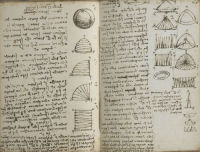Rule of Mathematics Click on the thumbnails to explore the trail
Read more about this trail (expand)
Leonardo believed that all things in nature were governed by mathematics. Mathematics was of supreme importance and expressed incontrovertible, universal truth. Knowledge of mathematics was a prerequisite for understanding the nature of all things. “Let no-one who is not a mathematician read my principles”, Leonardo said. Geometry and its actual or potential relationship to natural forms provided a suitably visual means for the exploration of mathematical “truths”.

- Enlarge
- Zoom & explore
- Fol 24v-25r - Squaring the circle. Photo RMN - © René-Gabriel Ojéda
Paris Manuscript E 1513-14
Leonardo relished the challenge of geometric puzzles. Sheet 24v of Manuscript E is one of many devoted to the ancient Archimedean conundrum of “squaring the circle”, that is how to construct a square equal in area to a given circle.
For this method, Leonardo used a sphere instead of a circle. He claims that a calculation of the area one eighth of the sphere will provide the solution, and so he proceeds to divide it into eight equal parts. He then takes one part and divides it into equal sections, noting how the curvature of the two sides becomes straightened, rather mysteriously “by motion over a plane location”. The next diagram shows the section transformed into a quarter circle divided into equal radiant segments. Finally, these are re-arranged to form a rectangle, but not before their curved edges are “made straight by motion”.
Leonardo never did solve the problem. In fact it was impossible. The effort that he expended on it now seems rather poignant. However, his understanding of geometry gained by this type of study lead to a deeper understanding of organic structures such as the valves of the heart.
In Leonardo's words
The night of St. Andrew’s day, I came to the end of the squaring of the circle and it was the end of the night and of the paper on which I was writing. It was concluded at the end of the hour.
The primary concern of this manuscript is the study of weights (De Ponderibus) and the effects of gravity, demonstrating the influence of Jordanus of Nemore and Archimedes on Leonardo.
The manuscript also contains drawings of an invention designed to assist in the draining of the Pontine marshes south of Rome, as well as notes on geometry, painting and the flight of birds.
Originally comprised of 96 folios, the homogeneity of the writing style and absence of blank pages in this manuscript confirm that it was produced during a relatively short period of time.
- Medium Pen and ink on paper
- Size 15 x 9.9 cm
- Location Bibliothèque de l’Institut de France










